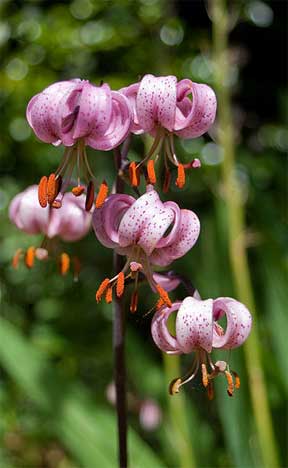Martagon lilies hail originally from Europe. But they have spread far and wide since, thanks in part to their astounding beauty. Also known as Turk’s Cap lilies, owing to the way their petals curl back toward the stalk, wildflowers species in this division are found as far away as Mongolia.
Unlike most Asiatic lily species, the Martagon is shade tolerant. They’re also much less likely to be favored by deer, so you can grow them in numerous locations around the home and not fear they’re dying or being eaten. They also grow well in pots, but take care to choose a large one. Martagon stalks can reach up to six feet high.

Because they flower in mid-summer, they make excellent companions to other lilies, such as the Asiatic Luxor, which blooms in late May to early June. That allows you to have lilies during the entire growing season.
Like Asiatic lilies they are hardy. They can be grown in a variety of zones ranging from 3-6 and have the same love for well-draining soil. They sport large whorls of green leaves and a flower that hangs face-down on tiny short stems off the main stalk. That posture makes them a helpful contrast to sun-facing flowers so your garden can have even more variety with a Martagon.
That variety is enhanced by their smaller petals. Martagons offer smaller blooms than their Asiatic or Oriental cousins, making for a beautiful display in the pot, hothouse, or outdoors. Since they resemble (and, in many places, are) wildflowers they offer yet another distinctive difference that can liven up any floral display.
Beware of one aspect before selecting them, though. Martagons grown from seed take several years to produce blooms. Growing them from a shortcut (a bulb which has had its outer layers removed) can cut that time in half, but those still require about three years to flower. However, if you acquire a developed plant, they will blossom annually like any other perennial.
Once they do flower, you’ll be delighted. Purebred petals come in pink, magenta, rose, or white. Hybrids expand the range to include a variety of other colors, as well as some mottled styles.
Like other lilies they enjoy a slightly acidic soil, but unlike others they can tolerate a range much better. Anything from 5.6 (acidic) to 8.5 (alkaline) can offer a suitable growing environment for these lovely plants.
The purebreds are any one of five different species: L. distichum, L. hansonii, L. martagon, L. medeoloides or L. tsingtauense. However, hybrids such as the Brocade are equally lovely. Sporting pink petals with small darker spots, their anthers feature a large orange oval that makes for a beautiful display. Another, the Mrs. R.O. Backhouse, offers a display of up to 30 fuzzy, amber buds. Cold hardy, it makes for a stunning lily by any standard.



{ 0 comments… add one now }
You must log in to post a comment.